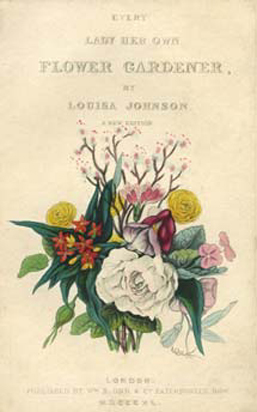
TO VICTORIAN SENSIBILITIES, gardening was an eminently suitable occupation for a lady, combining fresh air and moderate exercise with self-improvement. Middle-class women took up gardening as a hobby, tending their own suburban patch, and developing interests in the associated activities of flower-arranging, fern-collecting and botanical art. Tools were manufactured specifically for female use, and gardening manuals for ladies were published, giving instruction in garden tasks suitable for women, and advice on planting and colour schemes. John Loudon’s wife, Jane, exceeded the sales of her husband’s horticultural books with her own successful volumes aimed at women gardeners, such as Instructions in Gardening for Ladies of 1840 and The Ladies’ Companion to the Flower Garden, published in 1841. Herself a self-taught gardener, Jane Loudon recognised the need for simple, easy-to-follow gardening manuals aimed at the amateur gardener who was literate and enthusiastic but had little scientific knowledge or practical training.
Although gardening was acceptable as a hobby for women, as a profession it was regarded as unseemly. The garden bothy was a strictly male domain, so a traditional garden apprenticeship was out of the question, and women were deemed incapable of the heavy work involved in gardening. It was not until the last decade of the nineteenth century that women were offered places on horticultural training courses, and even then it was considered an unorthodox career path. Improvements in access to education and the rise of the professional middle classes created a group of young, educated, affluent women in search of an occupation acceptable to their place in society. Their options were limited to the respectable professions of teaching, nursing or working in a shop or office.
By the end of the nineteenth century, women had gained some rights that were paving the way towards equality. Social attitudes towards women were slowly changing, but they were still regarded primarily in their domestic role as wives and mothers. Manual work such as gardening was considered unsuitable for ladies until the advent of the First World War forced a change in attitude. The jobs left behind by men departing for the trenches were taken up by women and provided an opportunity for them to prove their capability in professions such as gardening. The social change that followed in the aftermath of war eventually brought the vote to women and the freedom to pursue a career of their choosing.

The popularity of gardening created a market for books specifically designed for amateur women gardeners, such as Louisa Johnson’s Every Lady Her Own Flower Gardener, published in 1840.
It took time for women to be accepted in roles formerly dominated by men. Female gardeners were employed at the Royal Botanic Gardens, Kew, from 1896, with Annie Gulvin and Alice Hutchings being the first to take their place alongside male recruits, and they were soon joined by others. There was some initial consternation about what the female gardeners would wear, as skirts were liable to brush against the plants and damage them. The amusing novelty of women gardening in bloomers prompted ridicule in the press. In 1900 Fun magazine responded to this extraordinary sight in verse:
They gardened in bloomers, the newspapers said;
So to Kew without warning all Londoners sped:
From the roofs of the buses they had a fine view
Of the ladies in bloomers who gardened at Kew.
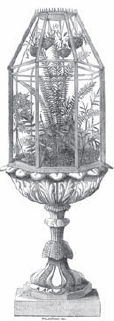
The collection and display of ferns was deemed a suitable occupation for ladies who had an interest in horticulture, and ornamental indoor fern cases brought gardening into the domestic realm.

Gardening was taught to schoolgirls for the value of its moral lessons. The feminine virtues of patience, diligence and tender care could be demonstrated through nurturing plants, and the girls would benefit from fresh air and exercise.

Botanical painting was a hobby that allowed women to pursue an interest in plants without breaking any of the social conventions associated with practical gardening. Some women had their work published, others displayed their paintings in albums.
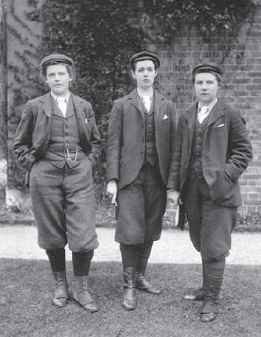
Three of the first women to be employed as gardeners at Kew were Alice Hutchings, Gertrude Cope and Eleanor Morland, who trained at Swanley College together. They are photographed wearing the same gardening uniform as their male colleagues, c. 1896.
To resolve the difficulty, the women were permitted to wear the same practical working clothes as their male colleagues, so they set to work in breeches, waistcoats, peaked caps and heavy boots, liberating them from the long skirts and tight waistbands of Victorian convention.
The women employed at Kew had received their horticultural training at Swanley College in Kent. The college was established in 1889 and began to admit female students in 1891. Women were housed in separate accommodation to the male students and were seated at the back of the classroom, always accompanied by a chaperone. The number of female students at the college increased, as did their success in examinations, and in 1901 the college became an all-female institution, with an excellent reputation for horticulture. Students were charged £80 a year for tuition, board and lodgings, and had to provide their own books, bedding, towels and dinner napkins. They also had to purchase their own uniform, which included a tunic and coat of Swanley tweed for winter and a lighter green tunic for summer, blouses, stockings, blazer, belt, jersey, brown felt or straw hat, strong brown boots, clogs, mackintosh, gardening gloves and a blue serge apron.
Two other graduates of Swanley College, Annie Morison and Lina Barker, moved north in 1897 to work at the Royal Botanic Garden in Edinburgh, where they were the first female gardeners to be employed. Recognising the need for horticultural training courses specifically for women, of which there were none in Scotland, they established the Edinburgh School of Gardening for Women in 1903, initially based at Inveresk but later moving to Corstorphine. Other gardening schools became established around this time, some specifically for women, and some, such as Writtle College in Essex, accepting women on a co-educational basis.
Practical training in agriculture and horticulture was made available to women through the initiative of Frances Evelyn Greville, Countess of Warwick (1861-1938). Known as ‘Daisy’, Lady Warwick was rich, hedonistic and independent, but also concerned with social justice. In order to provide employment opportunities for the daughters of professional families, she promoted the idea of working in rural occupations such as gardening and light farming, and in 1898 established the Lady Warwick Hostel in Reading. In association with Reading College, women were trained in horticulture, market gardening and fruit growing, as well as dairy work, poultry farming and bee keeping. The college staff provided lessons on the theory of horticulture while practical work was done in the grounds of the hostel, under the management of the warden, Edith Bradley.

Studley College was established in 1898 to train women in horticulture. The grounds at Studley Castle had ample space for glasshouses where the students could practise techniques of fruit production, as shown in this photograph of thegrape house, c. 1910.
The courses proved popular and in 1899 two further hostels were opened in Reading, and in the first six years over two hundred students were enrolled. In 1903 the establishment moved to Studley Castle in Warwickshire, bought by Lady Warwick at her own expense for £25,000, and now named Lady Warwick College. The institution now operated independently of Reading College, offering its own classes and lectures. Lady Warwick’s social causes and improvement schemes had soon expended most of her fortune and she was forced to scale back her activities, relinquishing control of the college in 1908. The school was renamed Studley College and by 1916 had been recognised by the Royal Horticultural Society as an approved training institution.
Another aristocratic lady concerned with training women for careers in horticulture was Frances, Viscountess Wolseley (1872–1936). Lady Wolseley was an ardent campaigner for agricultural reform, the revival of rural industries and fair pay for women, and when her family settled in rural Sussex she established the Glynde School for Lady Gardeners. Founded in 1902, the horticultural school offered two-year courses in gardening and garden design to young women in the grounds of her parents’ house, moving to larger premises just outside Glynde village in 1907. The new site included student accommodation and a 5-acre teaching garden. The students were organised in military fashion, the working day beginning early, and the rules were rigidly enforced, with transgressions punished with fines, and good behaviour rewarded with medals. The students wore a uniform comprising a long skirt, white blouse and felt hat with a khaki-coloured coat, and for practical work, breeches, gaiters and boots. The breeches made gardening activities more manageable, but were worn under a short skirt to maintain respectability.

Glynde School for Lady Gardeners was founded in 1902 by Frances Wolseley and provided horticultural training for women until the school closed in 1916.

The female students at Studley College learned through practical instruction in the college gardens. This photograph shows a lesson in pruning, c. 1910.
The school set high standards, both in horticulture and in the conduct of its students, and aimed to equip young women with the practical skills and artistic awareness essential for a career in gardening, although the focus on practical training was at the expense of science, with neither botany nor chemistry on the curriculum. Despite the patronage of influential figures such as Gertrude Jekyll, Ellen Willmott and William Robinson, the Royal Horticultural Society refused to recognise Glynde School as a training institution, and the students who sat official examinations rarely passed them.
Of those women who graduated from horticultural college, some took up teaching positions and others found employment at institutions such as the Royal Botanic Gardens, Kew, where they could continue their horticultural training while being paid a weekly wage. Annie Gulvin, one of the first women to work at Kew, was the first of them to be appointed head gardener in a private garden, aged only twenty. She was employed in the garden at Iscoed in Carmarthen, where she managed a staff of five and successfully improved the condition of the run-down garden and gained the respect of her fellow gardeners and employer. After a year, she moved on to Burstall in Suffolk but her horticultural career was to come to an end not long afterwards, prompted by her marriage in the summer of 1900. Her job at Burstall was taken on by her contemporary at Kew, Alice Hutchings, who had by then risen to the position of sub-foreman of the alpine pits. Two years later she, too, was married and obliged to resign her post. The conventions of society, although slowly changing, still meant that it was socially unacceptable for married women of the middle classes to work. Women were forced to choose between a career and a family, and many of the early pioneers of horticultural training laid down their spades in favour of marriage.
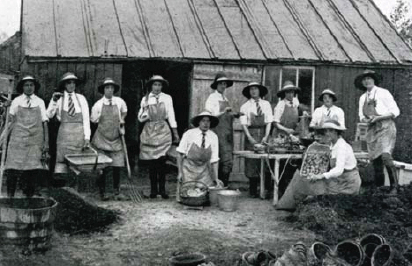
A group of students at Glynde School, pictured in c. 1910. The women are wearing boots and breeches under their long gardening aprons.
The horticultural courses on offer to women were aimed at the middle classes. Fees were charged for lectures and practical tuition, and board and lodgings created further expense, as did the purchase of a uniform and stout boots. Gardening was becoming an accessible profession for middle-class women, while the working classes still provided female labour in private gardens and nurseries for the menial tasks of weeding, raking and picking, work that was poorly paid, physically demanding and seasonal.
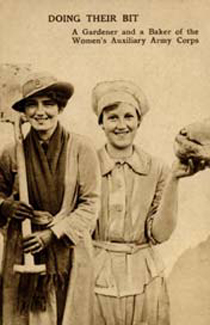
As men departed for the front during the First World War, women took over their jobs at home, proving themselves to be capable of hard manual work such as gardening.
Through the campaigning of women such as Lady Warwick and Lady Wolseley, the writings of Jane Loudon, and the determined contribution of working female gardeners, women were gradually gaining a place in the profession of horticulture. Reputations in garden design and plantsmanship were established by women such as Gertrude Jekyll, Norah Lindsay and Ellen Willmott as women made their mark in a male-dominated profession, and more and more women chose to enrol on horticultural courses to equip them for a career in gardening. During two world wars these skills proved vital as women filled the gardening positions of men who enlisted for war service, and it was women who fronted the campaign to ‘Dig for Victory’.

This portrait of Joseph Paxton by Henry Perronet Briggs (1793–1844) was commissioned in 1836 by his employer, the Duke of Devonshire, as a mark of respect for his favoured head gardener.